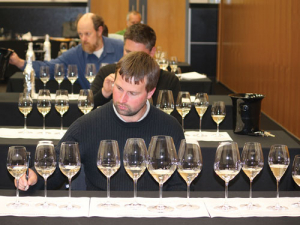Sauvignon Blanc New Zealand 2027 to unite and reinvigorate the wine industry
Sauvignon Blanc New Zealand 2027 is perfectly timed, given the period of turbulence and change in New Zealand wine, says committee chair Natalie Christensen.
 Damian Yvon from Clos Henri, was one of the panel trying to determine which glass is the perfect one for Sauvignon Blanc.
Damian Yvon from Clos Henri, was one of the panel trying to determine which glass is the perfect one for Sauvignon Blanc.
For the second time this year, a panel of winemakers and industry personnel in Marlborough spent time considering what constitutes the perfect Sauvignon Blanc glass.
With the help of 10th generation patriarch Georg Riedel, the panel spent an afternoon tasting the region’s flagship wine, from a range of 11 individually styled glasses. As more and more were eliminated for various reasons, it came down to two – both extremely similar in style and size.
It is not the first time Riedel’s patriarch has been involved in helping discover the perfect varietal glass here in New Zealand. A few years ago, he ran similar seminars in Central Otago and finally with the help of a number of wine experts, the 260-year-old company produced a Pinot Noir glass that presents Central Otago wines in the best possible light.
Riedel are now set on producing a Sauvignon Blanc glass that shows off the unique aromatics of Marlborough’s wine.
While you might think it is all just marketing hyperbole that the glass changes the taste of a wine – no one on the testing panel would agree with you. The differences in both aromas and impact on the palate were obvious to all, when the same wine was drunk from a variety of glass styles.
With 11 glasses set in front of them, the panel had four flights of wine to taste. On the first flight, each person had to eliminate three glasses. Another three were eliminated on flight two, (with a different wine), and again on the third flight. That left just two glasses on the table. And that was where the hard work really began. Both were similar styles, (see picture) and there was some discussion on just which showed off the variety best. In the end it required a second tasting comparison for a final decision to be made. Glass three, a Champagne Wine Glass was the winner, just – over glass 10, which was a Malvasia.
Ironically in the first panel tasting back in June, it was glass 10 that won and glass three was second.
So why is it that glass shape and size changes the wine? Georg Riedel says it is not so much changing the wine, as changing the interpretation of the wine.
“If you compare wine to music – music does not change, but the interpretation of the music changes very, very much. The same with wine. If you try a wine in each of the glasses, you will be astonished about the difference in aroma and taste.”
Everybody understands there is a lot of science involved in winemaking – but the glass you drink that wine from is equally a work of science. Riedel explained that the bowl of the glass comes with three very distinct parameters.
“First size, then its shape and finally, the opening of the glass The flow of liquid to our palate depends on these three parameters which then generates a different perception of the same wine.”
He says size is very important, but so too is shape. The larger bowl style glasses in the Sauvignon Blanc tasting failed to deliver significant aromatics, proving his point.
As for the opening of the glass it’s importance lies in how you have to place your head to drink. Does the opening deliver to the full mouth or does it confine the liquid to the tongue? Either way will impact on the taste sense, as Cloudy Bay winemaker Tim Heath pointed out when asked why he chose glass three over glass 10.
“(With glass 3) the wine washed around the sides of my mouth and I felt there was more structure and influence around that. The other glass (10) it poured straight down the middle of my tongue.”
Riedel explained the differences between the two glasses – admitting he preferred the second place getter, glass 10.
“This glass has a tinier, more narrow opening, which with gravity you move your head back and it gives a little more push on the wine, it goes more to the centre of the palate. Whereas glass three would go more forward of the palate.”
So what now? Good question. Riedel have left the two winning glasses with each of the panel and has asked them to continue to compare them against each other, to confirm the earlier decision. But it just may be that the perfect glass to drink a Marlborough Sauvignon Blanc is the same as that for a Champagne wine.
That doesn’t seem like too bad a result, particularly in terms of status.

The end of the year is fast approaching, so here are some thoughts on a few of the significant developments…

OPINION: When I moved to Marlborough two decades ago, I found countless lines of tidy vines, neatly mowed and carefully…
The large 2025 harvest will exacerbate the wine industry's "lingering" supply from recent vintages, New Zealand Winegrowers Chief Executive Philip…
If you find a new consumer in a developed wine market, you are taking them from someone else, says Blank…
OPINION: Sauvignon Blanc was famously introduced to New Zealand by Ross Spence of Matua Valley, and then serendipitously planted in…